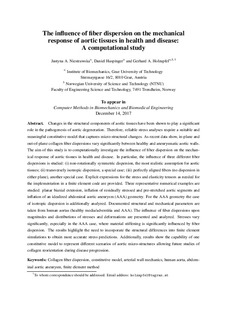| dc.contributor.author | Niestrawska, Justyna A | |
| dc.contributor.author | Ch Haspinger, Daniel | |
| dc.contributor.author | Holzapfel, Gerhard | |
| dc.date.accessioned | 2019-03-06T12:28:09Z | |
| dc.date.available | 2019-03-06T12:28:09Z | |
| dc.date.created | 2018-11-20T14:04:51Z | |
| dc.date.issued | 2018 | |
| dc.identifier.citation | Computer Methods in Biomechanics and Biomedical Engineering. 2018, 21 (2), 99-112. | nb_NO |
| dc.identifier.issn | 1025-5842 | |
| dc.identifier.uri | http://hdl.handle.net/11250/2588997 | |
| dc.description.abstract | Changes in the structural components of aortic tissues have been shown to play a significant role in the pathogenesis of aortic degeneration. Therefore, reliable stress analyses require a suitable and meaningful constitutive model that captures micro-structural changes. As recent data show, in-plane and out-of-plane collagen fiber dispersions vary significantly between healthy and aneurysmatic aortic walls. The aim of this study is to computationally investigate the influence of fiber dispersion on the mechanical response of aortic tissues in health and disease. In particular, the influence of three different fiber dispersions is studied: (i) non-rotationally symmetric dispersion, the most realistic assumption for aortic tissues; (ii) transversely isotropic dispersion, a special case; (iii) perfectly aligned fibers (no dispersion in either plane), another special case. Explicit expressions for the stress and elasticity tensors as needed for the implementation in a finite element code are provided. Three representative numerical examples are studied: planar biaxial extension, inflation of residually stressed and pre-stretched aortic segments and inflation of an idealized abdominal aortic aneurysm (AAA) geometry. For the AAA geometry the case of isotropic dispersion is additionally analyzed. Documented structural and mechanical parameters are taken from human aortas (healthy media/adventitia and AAA). The influence of fiber dispersions upon magnitudes and distributions of stresses and deformations are presented and analyzed. Stresses vary significantly, especially in the AAA case, where material stiffening is significantly influenced by fiber dispersion. The results highlight the need to incorporate the structural differences into finite element simulations to obtain more accurate stress predictions. Additionally, results show the capability of one constitutive model to represent different scenarios of aortic micro-structures allowing future studies of collagen reorientation during disease progression. | nb_NO |
| dc.language.iso | eng | nb_NO |
| dc.publisher | Taylor & Francis | nb_NO |
| dc.title | The influence of fiber dispersion on the mechanical response of aortic tissues in health and disease: a computational study | nb_NO |
| dc.type | Journal article | nb_NO |
| dc.type | Peer reviewed | nb_NO |
| dc.description.version | acceptedVersion | nb_NO |
| dc.source.pagenumber | 99-112 | nb_NO |
| dc.source.volume | 21 | nb_NO |
| dc.source.journal | Computer Methods in Biomechanics and Biomedical Engineering | nb_NO |
| dc.source.issue | 2 | nb_NO |
| dc.identifier.doi | 10.1080/10255842.2017.1418862 | |
| dc.identifier.cristin | 1632675 | |
| dc.description.localcode | This is an [Accepted Manuscript] of an article published by Taylor & Francis in [Computer Methods in Biomechanics and Biomedical Engineering] on [13 Feb 2018], available at https://doi.org/10.1080/10255842.2017.1418862 | nb_NO |
| cristin.unitcode | 194,64,45,0 | |
| cristin.unitname | Institutt for konstruksjonsteknikk | |
| cristin.ispublished | true | |
| cristin.fulltext | postprint | |
| cristin.qualitycode | 1 | |
